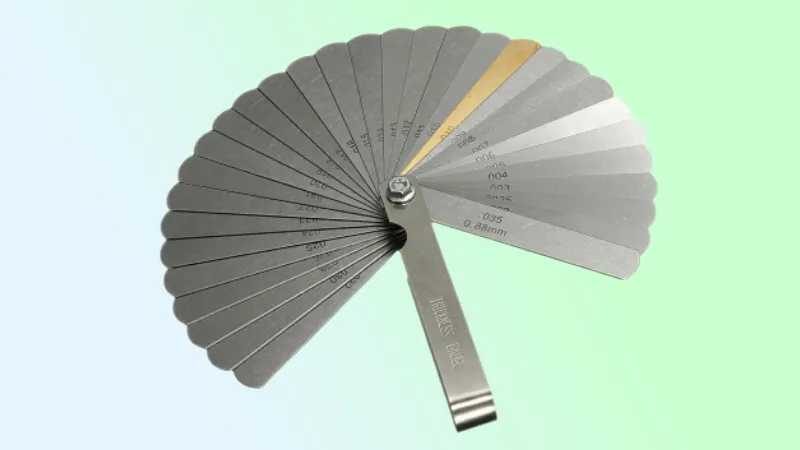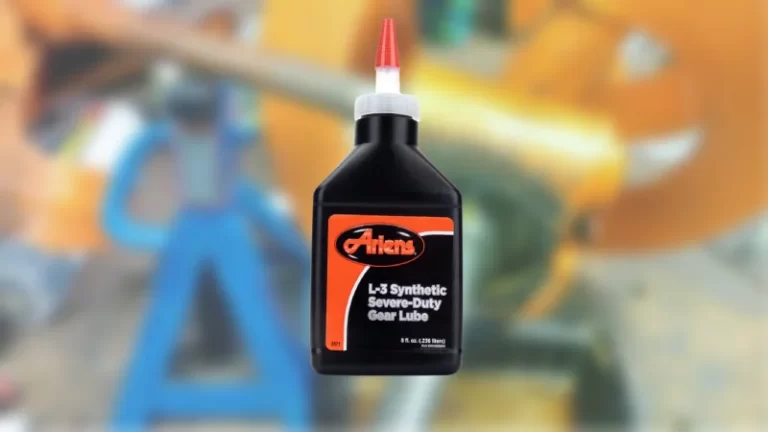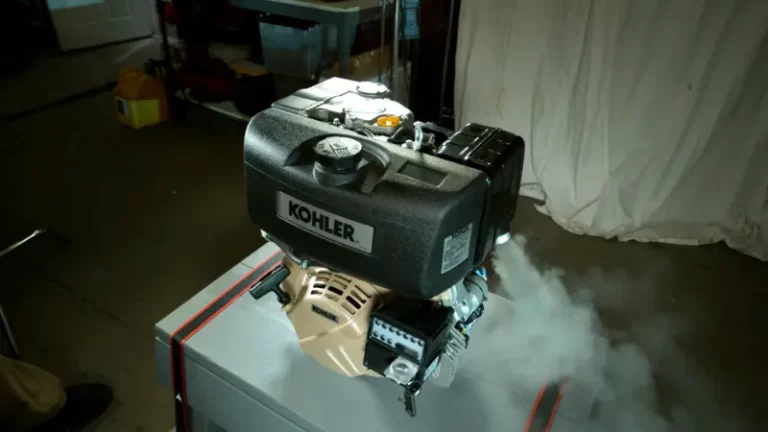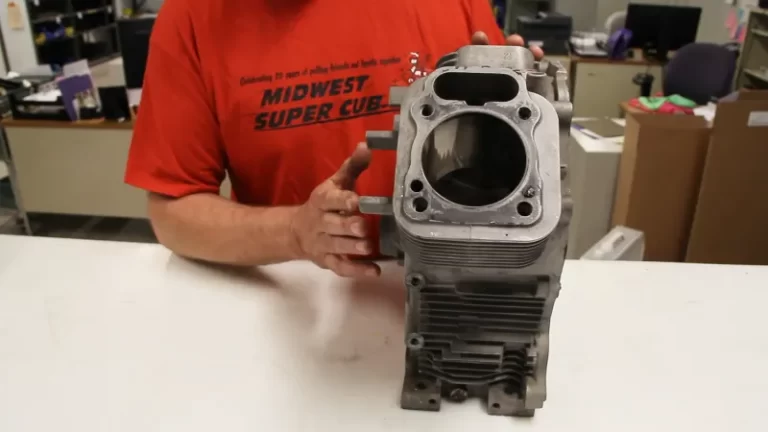No Feeler Gauge What Can I Use?

When it comes to performing precise measurements in mechanical or automotive work, a feeler gauge is a commonly used tool. However, it’s not always convenient to have one on hand. Whether you’ve misplaced your feeler gauge or never had one to begin with, there are alternative methods you can use to achieve accurate measurements.
In this article, we’ll explore a few of these methods and explain how they can be used effectively in place of a feeler gauge.
You'll Learn About
No Feeler Gauge What Can I Use?
A thin guitar pick can be used as an alternative to a feeler gauge for adjusting the standard neck dip of a guitar. However, it is important to note that fretwork should be exact and playing should be light to avoid any issues with a flat dip.
When adjusting valves on a Stihl Br 550, it is not recommended to use any alternative to a feeler gauge, as it is crucial to have the correct setting. Shims, wire gauges, or business cards should not be used as alternatives.
A foldable set of feeler gauges is available to purchase and ranges many feelers for any need.
Why a Feeler Gauge is the Best Tool for the Job?
When it comes to measuring small gaps and clearances, a feeler gauge is the go-to tool for many professionals and DIY enthusiasts. While it may seem like a simple piece of equipment, a feeler gauge has a number of advantages that make it the best tool for the job.
Accuracy is perhaps the most important advantage of using a feeler gauge. These gauges are designed to provide precise measurements of gap widths, ensuring that your work is accurate and consistent. This level of accuracy is especially important in applications such as engine building, where even the smallest gap or clearance can have a significant impact on performance.
Another advantage of using a feeler gauge is its versatility. Feeler gauges typically come with a range of different thicknesses, allowing you to measure gaps of various sizes. This versatility makes them useful in a wide range of applications, from automotive and mechanical work to carpentry and metalworking.
Perhaps one of the biggest advantages of feeler gauges is their affordability. These tools are relatively inexpensive and widely available, making them an accessible option for both professionals and hobbyists. Additionally, they are durable and designed to withstand frequent use, which means they will last for many years without needing to be replaced.
While there are other tools that can be used in place of a feeler gauge, such as a piece of paper or a set of calipers, they simply can’t match the accuracy, versatility, and affordability of a dedicated feeler gauge. Therefore, if you want to ensure precise and consistent measurements of gap widths in your work, a feeler gauge is the best tool for the job.
Common Alternatives to a Feeler Gauge
When a feeler gauge is not available, there are several common alternatives that can be used to measure gaps and clearances. These alternatives may not be as accurate as a feeler gauge, but they can be useful in a pinch.
Thin Guitar Pick
A thin guitar pick can be used to measure gaps and clearances, particularly in tight spaces where a larger tool may not fit. The thickness of the pick can be used to estimate the gap or clearance, but it may not be as precise as a feeler gauge.
Go/no-go Gauge
A go/no-go gauge is a specialized tool used to verify that a part meets the required specifications. It consists of a pair of pins, one of which is a go pin that should fit into the gap, and the other is a no-go pin that should not fit into the gap. If the go pin fits and the no-go pin does not, the gap is within the specified range.
Business Card or Paper
A business card or a piece of paper can be used to estimate gaps and clearances. By folding the card or paper in half, it can be used to measure gaps of a certain thickness. This method is not as precise as a feeler gauge, but it can be a useful alternative in a pinch.
Wire Gauge
A wire gauge, also known as a wire thickness gauge, is a tool used to measure the diameter of wires and cables. It can also be used to estimate the thickness of gaps and clearances by finding the wire gauge that matches the gap size.
Aluminum From a Can
The thin aluminum from a soda or beer can can be cut into thin strips and used as makeshift feeler gauges. The aluminum can be easily shaped to fit into tight spaces, and the thickness of the aluminum can be used to estimate gap sizes.
Shim Stock
Shim stock is a thin material used to fill gaps and provide support. It is available in various thicknesses and can be used to measure gap sizes by selecting the appropriate thickness of shim stock.
While these alternatives may not be as accurate as a feeler gauge, they can be useful in a pinch. It is important to note that using an alternative tool may not provide precise measurements and could lead to errors in the final product. Therefore, it is always recommended to use the appropriate tool for the job whenever possible.
Pros and Cons of Each Alternative
Thin Guitar Pick
Pros:
- Guitar picks are easily accessible and widely available
- They come in varying thicknesses, making them versatile for different applications.
- They are flexible and can be easily maneuvered into tight spaces.
Cons:
- Guitar picks are not standardized for measurement, which can lead to inaccuracies.
- They may not be as precise as a feeler gauge, particularly for measurements that require extremely small tolerances.
Go/no-go Gauge
Pros:
- Go/no-go gauges are specifically designed for checking if a part falls within an acceptable range of tolerance.
- They are available in a variety of sizes and shapes for various applications.
- They provide a quick and easy way to determine whether a part is within tolerance.
Cons:
- They are not as versatile as feeler gauges, which can measure gaps of varying sizes.
- They can be more expensive than other alternatives.
Business Card or Paper
Pros:
- They are widely available and can be easily found in most workplaces or homes.
- They are flexible and can be easily shaped to fit into tight spaces.
- They can provide a quick and temporary solution for measuring small gaps.
Cons:
- They are not standardized for measurement, which can lead to inaccuracies.
- They may not be precise enough for applications that require extremely tight tolerances.
- They may not be as durable as other alternatives, such as shim stock.
Wire Gauge
Pros:
- Wire gauges are designed specifically for measuring gaps and are available in a wide range of sizes.
- They are durable and long-lasting, making them a good investment.
- They can be more precise than some other alternatives.
Cons:
- They may not be as versatile as feeler gauges, which can measure gaps of varying sizes.
- They can be more expensive than other alternatives.
Aluminum From a Can
Pros:
- Aluminum from a can is a cheap and easily accessible alternative.
- It is flexible and can be easily shaped to fit into tight spaces.
Cons:
- It is not standardized for measurement, which can lead to inaccuracies.
- It may not be as durable as other alternatives.
- It may not be precise enough for applications that require extremely tight tolerances.
Shim Stock
Pros:
- Shim stock is a standardized material specifically designed for measuring gaps.
- It is available in a wide range of sizes and thicknesses for various applications.
- It is durable and long-lasting, making it a good investment.
Cons:
- It can be more expensive than some other alternatives.
- It may not be as easily accessible as some other alternatives.
- It may not be as flexible as some other alternatives, making it difficult to use in tight spaces.
Each alternative to a feeler gauge has its own set of advantages and disadvantages. The best alternative depends on the specific application and the level of precision required. While some alternatives may be more affordable or easily accessible, they may not provide the same level of accuracy as a feeler gauge.
It is important to choose an alternative that is suitable for the specific task at hand and provides the necessary level of accuracy.
Comparison of Alternative Feeler Gauge Tools
| Tool | Pros | Cons |
|---|---|---|
| Thin guitar pick | Widely available, versatile, and inexpensive | May not have the precision needed for some jobs |
| Go/no-go gauge | Can be more accurate than a guitar pick, designed for specific measurements, easy to use | Limited range of measurements, can be expensive |
| Business card or paper | Widely available, easy to find, and versatile | May not be precise enough for some applications and can be difficult to hold in place |
| Wire gauge | Precise measurements, easy to use, and durable | Limited range of measurements, can be expensive |
| Aluminum from a can | Readily available, free, and versatile | Can be difficult to cut and may not be precise enough for some applications |
| Shim stock | Precise measurements, wide range of thicknesses, and durable | Can be expensive and not widely available |
Frequently Asked Questions
Q1. What is a go/no-go gauge and how is it used as an alternative to a feeler gauge?
A: A go/no-go gauge is a tool used to verify whether a part meets the predetermined specifications for acceptance or rejection. It consists of two gauges, a go gauge and a no-go gauge. The go gauge has a predetermined minimum and maximum dimension, and if the part fits within this range, it is accepted.
The no-go gauge has a predetermined maximum dimension, and if the part is larger than this, it is rejected. In some cases, the go/no-go gauge can be used as an alternative to a feeler gauge to check the gap between two parts.
However, it is important to note that the go/no-go gauge is only suitable for checking gaps within its predetermined range and cannot be used to measure the actual size of the gap.
Q2. How can a wire gauge be used as an alternative to a feeler gauge?
A: A wire gauge is a tool used to measure the diameter of wire or the thickness of sheet metal. It consists of a series of wire or metal plates of varying thickness, each with a corresponding measurement marked on it.
To use a wire gauge as an alternative to a feeler gauge, the user selects a wire or metal plate of the appropriate thickness and inserts it into the gap between the parts being measured. The wire or plate should be as close to the size of the gap as possible.
While a wire gauge can provide a rough estimate of the gap size, it is not as accurate as a feeler gauge, and the user may need to try multiple wires or plates to find one that fits properly.
Q3. Can a thickness gauge be used as an alternative to a feeler gauge?
A: A thickness gauge, also known as a micrometer, is a tool used to measure the thickness of materials. While it may be possible to use a thickness gauge as an alternative to a feeler gauge in certain situations, it is not recommended.
Thickness gauges are designed to measure the thickness of a single material, such as sheet metal, and are not intended for measuring gaps between two parts. Additionally, thickness gauges may not have the necessary level of precision required to measure small gaps accurately.
Q4. How can a piece of aluminum from a can be used as an alternative to a feeler gauge?
A: To use a piece of aluminum from a can as an alternative to a feeler gauge, the user can cut a thin strip of aluminum from the can and insert it into the gap being measured. The thickness of the aluminum strip can be adjusted by sanding or filing it down until it fits snugly into the gap. While this method can provide a rough estimate of the gap size, it is not as accurate as a feeler gauge, and the user may need to try multiple strips of aluminum to find one that fits properly.
Q5. What should be kept in mind when using an alternative to a feeler gauge?
A: When using an alternative to a feeler gauge, it is important to keep in mind that the alternative may not be as accurate as a feeler gauge, and the user may need to try multiple options to find one that works properly. Additionally, the alternative may not be suitable for all types of gaps or materials, and the user should exercise caution to avoid damaging the parts being measured. It is also recommended to only use alternatives in a pinch, and to invest in a feeler gauge for more precise measurements in the future.
Closing Thoughts
A feeler gauge is the best tool for precision measuring due to its accuracy, versatility, and affordability. However, if you find yourself without a feeler gauge, there are several common alternatives that can be used in a pinch.
Each alternative has its pros and cons, and the suitability of the alternative will depend on the specific task at hand. It is important to exercise caution and care when using these alternatives, and it is recommended that they are only used as a temporary solution until a proper feeler gauge can be obtained.
It’s always a good idea to have a backup plan and alternative tools on hand in case of emergencies. With this knowledge, you can confidently tackle your precision measuring tasks with or without a feeler gauge.






